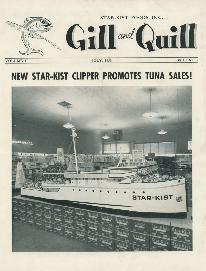 |
| Star-Kist in-house newsletter features one large-scale marketing effort at a local grocer, July 1955, ~ Matich Family Collection |
|
| Changes in the Kitchen
PROCESSED FOODS WERE CHANGING THE PACE IN AMERICAN KITCHENS. In 1952, the New York Times reported, “by using canned foods American housewives have helped free themselves from 34,000,000,000 work-hours annually in meal preparation time.” Instead of preparing a meal in four hours, the article states, housewives were now spending two.
Cookbooks & Gender Expectations
WHILE THE USE OF PREPARED INGREDIENTS WAS ON THE RISE, popular cooking manuals tended to perpetuate idealized
notions of women’s inclinations.
Women were informed, in the 1962 cookbook, How to Appeal to a Man’s Appetite,
that an occasional bad dinner can offend a friend but
regularly failed dinners can “Lose you a good deal more. Like your
husband.”
|
Idealized Comfort v. Technology and Household Change
Despite popular cookbook messages, in the 1950s, one-dish meals that
required canned foods were becoming more popular. Molds, loaves, and
casseroles are seen throughout the pages of several canned tuna
promotional booklets.
Food preparation was caught between two post-war ideologies: idealized comfort and modern speed and technology.
For
a time, a truce emerged. Both popular- and prepared food
promotional cookbooks expressed that time saved in preparation was a
chance to focus on creative presentation. Elaborate concoctions made
from processed foods, the “doctoring-up” of canned soup, and themed
meals became common suggestions.
|
|
While "cooking" with prepared foods has lost appeal, they were a
factor in destabilizing the idea of women’s fixed position in the
kitchen. The product of working women in the Terminal Island canneries
had influence in the softening of gender roles in the American kitchen.
|
|
|